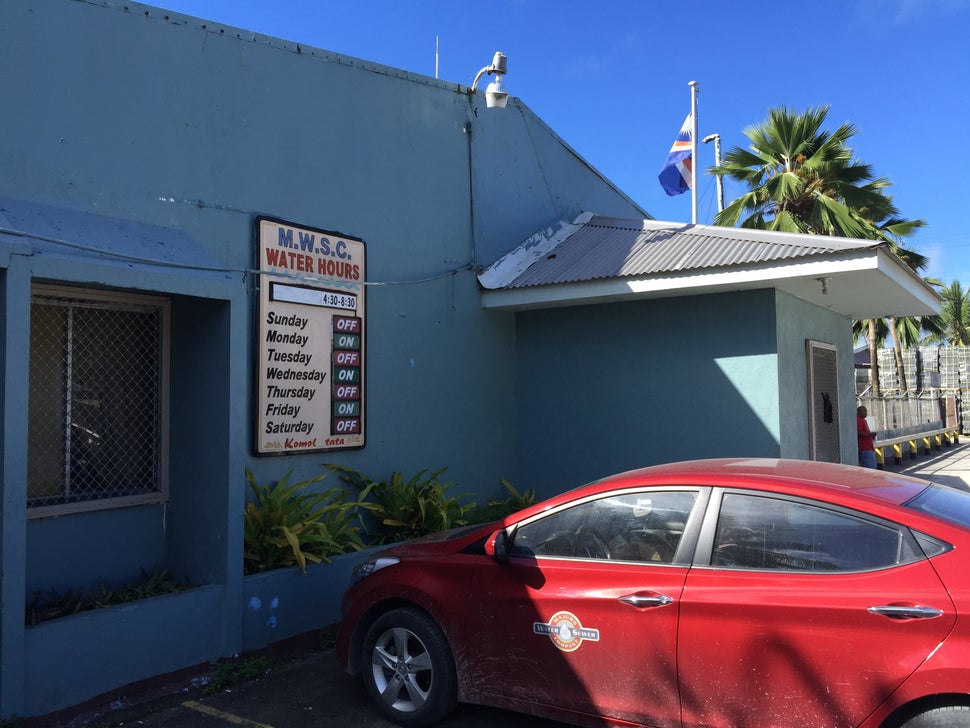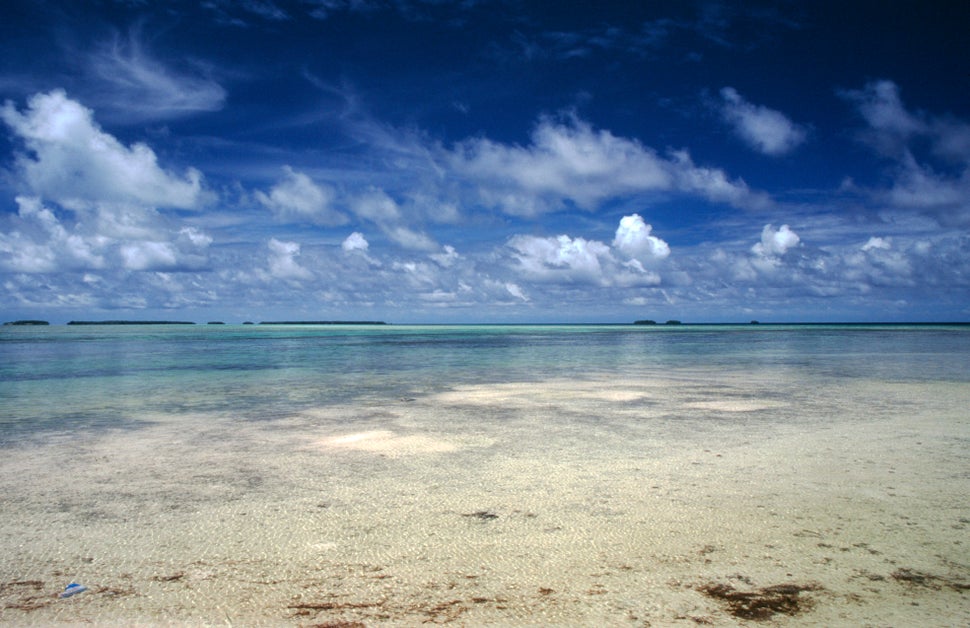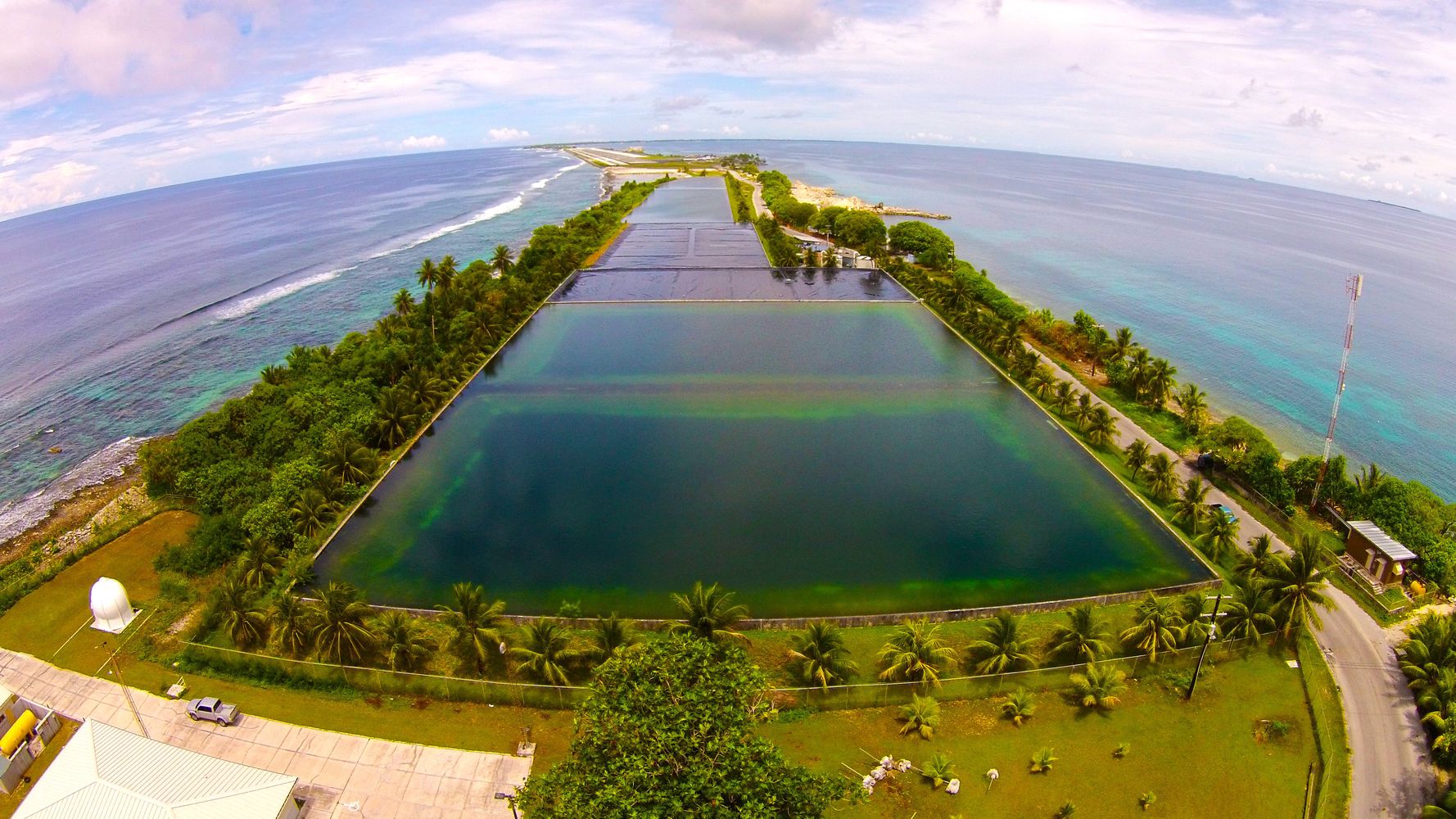Peter Mellgard is a deputy editor of Noema Magazine and the editor of the Berggruen Press.

MAJURO, Marshall Islands — A few yards from the crashing waves of the Pacific, on a precariously narrow strip of land, precious rainwater pools on the runway of the Marshall Islands’ main airport. This is how the government hydrates tens of thousands of its citizens: the rainwater runoff from the airstrip. The water — complete with bird droppings and whatever else has landed on the tarmac — is funneled via pipes to earthen storage reservoirs. From there, it gets filtered and treated and pumped to people down the atoll.
During a normal week the water only flows for 12 hours. In prolonged droughts, which are almost certain to happen in 2016, the reservoirs can get depleted to the last drop. The country can hold on for only a few months without rain. Thirsty Marshallese, many of whom rely on their own much smaller rainwater catchment containers, won’t have anything to drink or wash with. Dehydration, starvation, malnutrition and disease have been known to follow. Crops fail. Sensitive groundwater reservoirs become contaminated.
This is a bleak outlook for a vulnerable country in the remote Pacific, halfway between Hawaii and Australia. The Marshall Islands are a heavenly chain of white sandy beaches and coral reefs, but they are paradoxically one of the most inhospitable and challenging places to build a nation. Climate change will have numerous, complicated effects here. Access to freshwater, already in limited supply on the archipelago, is likely to become the most serious issue.
“It can become very complex very quickly,” Bill Shuster, a research hydrologist at the U.S. Environmental Protection Agency, told The WorldPost. “Nothing really prepared me for how closely connected everything is, how tightly coupled public health is to rainfall.”
 Peter Mellgard/The WorldPost
Peter Mellgard/The WorldPostAs the world enters the age of climate change, the tiny islands and atolls that make up the Marshall Islands are on the front lines. Here on the capital island, the Majuro Water and Sewer Company is already preparing for droughts that are predicted to be more intense and longer-lasting than what the country has seen before. Distant outer atolls are even more at risk than Majuro, the largest and most developed island. Some of the outer landmasses are so tiny and remote that only a few people live there. Many rely entirely on rain or imported bottled water.
“Before I came here, I’d never seen anything like this,” said Allen Gale, an Australian adviser to MWSC, which is the sole official gatekeeper of the water supply on the capital atoll. “It’s a tough life.”
The seven reservoirs near the airport hold about 34 million gallons total, according to Gale. MWSC gets about 140 million gallons of water off the runway each year. To give a sense of how little water that is, New York City provides about 1 billion gallons of water each day to its residents. That’s roughly 118 gallons per person per day, compared to Majuro’s 14 gallons.
Only about one-quarter of the people on Majuro are connected to the municipal water supply from the airport, however. The vast majority of people rely on rain, collecting it off the roofs of their homes. The rainwater trickles down gutters and into drums that hold 1,500 gallons at most. For most people on the island, this is their sole source for everything freshwater is used for — drinking, cooking, washing, cleaning. Each household has, on average, six to eight people to hydrate. During a drought, the drums can hold out for a month, maximum, at which point only the municipal supply remains viable.
This precarious situation is why Alington Robert, a longtime manager at MWSC, gets on the radio every Thursday evening and encourages his countrymen to connect their households to the more reliable and resilient municipal supply. Some years, like this one, he warns them to do what they can to prepare for drought.
 Photofusion/UIG via Getty Images
Photofusion/UIG via Getty ImagesWater scarcity is a perpetual worry in the Marshalls. The northern atolls get less than 50 inches of rain every year, according to a 2013 Australian government report. Atolls to the south get about double that. Bad droughts seem to be happening more often these days, a combined result of climate change and normal atmospheric oscillations. According to the latest climate change forecasts for this part of the Pacific, the Marshall Islands on average will get more rain in the coming decades, not less — but they’ll also get hotter temperatures, rising seas and longer and more intense droughts.
Only Majuro has a catchment system as sophisticated as the airport runway. Many other islands — and actually, much of Majuro as well — rely on underground water reservoirs that geologists call lenses. Shaped like the front of an eyeball, freshwater lenses are fed by rainwater and lie just below the surface of some atoll islands — but only the bigger ones, as Curt Storlazzi of the U.S. Geological Survey explained.
“The islands have to be wider than a few hundred meters to sustain a freshwater lens,” Storlazzi told The WorldPost. “Otherwise there’s just not enough surface area of the island to catch enough rain for freshwater to accumulate.”
Freshwater lenses are extremely sensitive and constantly shifting. They are often depleted during the dry season, getting so brackish that they can become undrinkable. When rain finally comes, it replenishes the lens, filtering down through the sandy soil and into the porous coral rock that forms the base of the atoll. The thickness of the lens depends on the size of the island, the amount of rainfall and the height of the ocean. As you go deeper, the water gets more and more saline. Eventually, it becomes pure seawater.
“If you were to put a well down, you’d get freshwater,” Storlazzi said. “But it’s a limited resource. That resource is tied to rainfall. If rainfall were to decrease in the future, that freshwater lens would not be replenished as frequently and [would] become thinner.”
Climate change poses a unique risk to islands that rely on freshwater lenses. In other vulnerable parts of the world — Miami, for instance — rising sea levels can lead to dangerous and damaging floods. But on an atoll island, rising sea levels threaten the survival of everything that lives there — people, animals and crops. Humans can’t really live in a place where the access to freshwater is unreliable.
As ocean levels rise, overwash events — where seawater flows over the surface of an island and seeps into its freshwater lens — will become more common. Storms are another cause of flooding, and as the height of the ocean increases, smaller and smaller storms can cause the same amount of flooding that the bigger, rarer storms do now. It can take months, even years, before the freshwater is suitable for drinking again. Even Majuro’s airport runway is vulnerable.
“If we get overtopping, where saltwater gets into our catchment, we have to dump [the freshwater] out into the lagoon,” Gale said. “As climate change comes in, it’s going to increase that danger.”
 Majuro Water and Sewer Company
Majuro Water and Sewer CompanySecuring a reliable water supply in a more extreme climate is going to be a huge challenge for residents of the outer islands in the Marshalls ― one that perhaps will prove insurmountable in the coming years. Out there, during drought, if the freshwater lens gets too saline to drink, it can take days for help to arrive.
One island on Maloelap Atoll, about 115 miles north of Majuro, appeared to be particularly vulnerable when Halston deBrum, MWSC’s operations manager, went to check on its freshwater situation not long ago.
“There is almost no land at all,” he said ― so, very little groundwater. “It was just hand-dug wells. These kinds of communities are very, very reliant on rainwater. If they go two or three weeks without rainwater, they have to search within the atoll for other sources of water.”
″[They] can’t drive,” deBrum added. “They go on a boat ― from their island to another and another.”
When things get really bad, MWSC, alongside the Marshallese government and international aid agencies, rushes solar-powered portable desalination machines to the outer islands, some of which are over a day’s journey by boat from Majuro. MWSC has 15 such machines, each of which produce about 360 gallons of water per day. There are far fewer machines than there are remote outer islands.
“It makes me nervous, yes,” said Joseph Batol, the head of MWSC. “Climate change here is real.”
This was produced by The WorldPost, which is published by the Berggruen Institute.
CORRECTION: This story originally misstated the amount of water New York City provides to its residents. It is 118 gallons per person per day, not 1,100.




